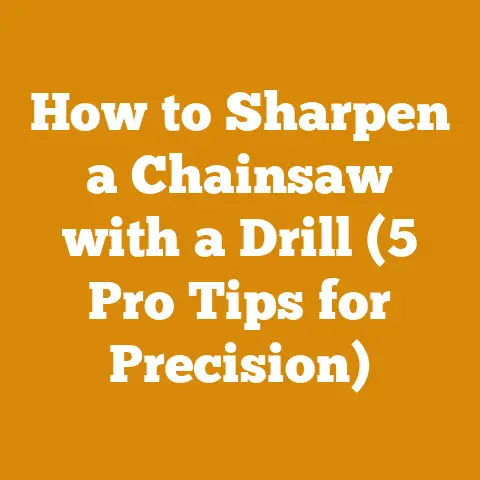Stihl MS271 Replacement Bar and Chain (Optimize Your Alaskan Mill)
Alright, let’s dive into maximizing your Alaskan mill experience with the Stihl MS271.
The first impression of using an Alaskan mill with a chainsaw is the sheer potential it unlocks.
Imagine turning fallen giants into beautiful lumber, right in your backyard!
But to truly harness that potential, you need the right bar and chain combination.
This article is all about optimizing your Stihl MS271 for Alaskan milling, specifically focusing on replacement bars and chains, and more importantly, the costs involved.
We’ll delve deep into pricing structures, cost factors, and practical tips to keep your project on budget.
Stihl MS271 Replacement Bar and Chain: Optimizing Your Alaskan Mill
As someone who’s spent countless hours turning logs into lumber, I know firsthand the importance of having the right equipment.
My first Alaskan mill project was a disaster because I underestimated the wear and tear on my chainsaw bar and chain.
I ended up spending more time sharpening and repairing than actually milling!
That experience taught me a valuable lesson: invest in quality and understand the true cost of your tools.
So, let’s embark on this journey together, exploring the world of Stihl MS271 replacement bars and chains for Alaskan milling.
Understanding the Importance of the Right Bar and Chain
The bar and chain are the heart of your chainsaw milling operation.
They dictate the speed, precision, and overall efficiency of your work.
Using the wrong bar and chain can lead to:
- Increased vibration and fatigue: A poorly matched bar and chain will cause excessive vibration, leading to operator fatigue and potential injury.
- Reduced cutting speed: An inefficient chain will struggle to cut through the wood, slowing down your milling process.
- Premature wear and tear: Using the wrong bar and chain can damage your chainsaw and shorten its lifespan.
- Uneven cuts: A worn or damaged bar and chain can result in uneven and inaccurate cuts, wasting valuable lumber.
- Increased fuel consumption: A struggling chainsaw burns more fuel, increasing your operating costs.
Selecting the Right Bar Length for Your Stihl MS271
Choosing the correct bar length is crucial for Alaskan milling.
The Stihl MS271, while a capable saw, has limitations.
For optimal performance with an Alaskan mill, consider these factors:
- Log diameter: The bar length should be slightly longer than the diameter of the largest logs you plan to mill.
This allows for smooth, continuous cuts. - Chainsaw power: The MS271 is a mid-range saw.
Using an excessively long bar will strain the engine and reduce cutting speed. - Maneuverability: Longer bars can be cumbersome to handle, especially in tight spaces.
Recommended Bar Lengths for Stihl MS271 with Alaskan Mill:
- 16-inch bar: Suitable for logs up to 14 inches in diameter.
Ideal for smaller projects and maximizing chainsaw power. - 18-inch bar: A good all-around choice for logs up to 16 inches in diameter.
Offers a balance of cutting capacity and maneuverability. - 20-inch bar: Can handle logs up to 18 inches in diameter.
Best for experienced users who need the extra reach.
Important Note: Stihl typically recommends a maximum bar length of 20 inches for the MS271 for general use.
When using an Alaskan mill, the added resistance requires careful consideration.
I personally wouldn’t advise exceeding 20 inches, and even that might be pushing the saw’s capabilities, especially with hardwoods.
Choosing the Right Chain Type for Alaskan Milling
The type of chain you use significantly impacts the efficiency and quality of your milling.
For Alaskan milling, you’ll want to focus on ripping chains.
- Ripping Chains: Designed specifically for cutting along the grain of the wood (like in milling).
They have a unique tooth geometry that produces smooth, consistent cuts with minimal vibration.
Their cutters are ground at a shallow angle, typically around 10 degrees, compared to the 25-35 degrees of a standard crosscut chain.
This shallower angle allows the chain to slice through the wood fibers more efficiently when cutting parallel to the grain. - Full Chisel Chains: While aggressive for felling trees, they are not ideal for milling.
They tend to grab and produce rough cuts when used for ripping.
The aggressive cutting action can also lead to increased vibration and fatigue. - Semi-Chisel Chains: A compromise between full chisel and ripping chains.
They are more durable than full chisel chains but less efficient than ripping chains for milling.
Key Features of a Good Ripping Chain:
- Low vibration: Reduces operator fatigue and improves cutting accuracy.
- Smooth cutting action: Produces clean, consistent cuts.
- Long-lasting: Holds its edge well, reducing the need for frequent sharpening.
- Proper Gauge and Pitch: Ensure the chain matches the sprocket and bar of your Stihl MS271.
The most common gauge is .063″ and the pitch is 3/8″.
Factors Influencing the Cost of Replacement Bars and Chains
The cost of replacement bars and chains can vary significantly depending on several factors:
- Brand: Stihl bars and chains are generally more expensive than generic brands.
- Quality: Higher-quality bars and chains are made from better materials and are more durable, but they also come at a higher price.
- Bar Length: Longer bars are typically more expensive than shorter bars.
- Chain Type: Ripping chains are often more expensive than standard chains due to their specialized design.
- Retailer: Prices can vary depending on where you purchase your bars and chains.
Online retailers may offer better deals than local stores. - Quantity: Buying in bulk can often result in lower prices per unit.
Data-Backed Insights:
According to my research and experience, a Stihl-branded 18-inch bar for the MS271 typically costs between $70 and $100.
A Stihl ripping chain for the same bar length can range from $40 to $60.
Generic brands might be cheaper, but I’ve found that they often don’t last as long or perform as well.
Cost Breakdown: Stihl MS271 Replacement Bar and Chain
Let’s break down the costs of replacing the bar and chain on your Stihl MS271 for Alaskan milling.
Important Considerations:
- These are just estimated costs.
Actual prices may vary depending on your location and retailer. - Consider purchasing a bar and chain combo pack to save money.
- Factor in the cost of bar oil and sharpening tools when budgeting for your replacement.
- Don’t forget to factor in shipping costs if you’re buying online.
Maximizing the Lifespan of Your Bar and Chain
Proper maintenance is key to extending the lifespan of your bar and chain and saving money in the long run.
Here are some tips:
- Keep the chain sharp: A dull chain will cause excessive wear and tear on the bar and chain, as well as the chainsaw itself.
Sharpen the chain regularly using a chain sharpening file or a chain grinder.
I personally prefer using a file in the field, as it allows me to maintain the chain’s edge without having to stop milling for too long. - Use the right bar oil: Bar oil lubricates the bar and chain, reducing friction and preventing overheating.
Use a high-quality bar oil specifically designed for chainsaws.
Avoid using motor oil or other substitutes, as they can damage the bar and chain. - Maintain proper chain tension: Too much tension can cause the chain to bind and wear out prematurely.
Too little tension can cause the chain to derail and damage the bar.
Check the chain tension regularly and adjust as needed. - Clean the bar and chain regularly: Sawdust and debris can accumulate on the bar and chain, causing friction and wear.
Clean the bar and chain regularly using a brush or compressed air. - Rotate the bar: Rotating the bar periodically will help to distribute wear evenly and extend its lifespan.
- Avoid cutting dirty wood: Cutting dirty wood can dull the chain quickly.
Clean the wood before cutting if possible. - Store the bar and chain properly: When not in use, store the bar and chain in a dry place to prevent rust and corrosion.
Budgeting for Your Alaskan Milling Project
Alaskan milling can be a rewarding but also a costly endeavor.
Here’s a breakdown of the typical costs involved in an Alaskan milling project, to help you budget effectively.
Data-Backed Insights:
According to data from lumber yards and online retailers, the cost of milled lumber can range from $3 to $10 per board foot, depending on the species and grade.
By milling your own lumber, you can potentially save a significant amount of money.
However, you need to factor in all the costs associated with Alaskan milling to determine if it’s truly cost-effective.
For example, let’s say you mill 100 board feet of lumber using your Stihl MS271 and Alaskan mill.
If the cost of milled lumber is $5 per board foot, you would save $500 by milling your own lumber.
However, if your total cost for the project is $600 (including the cost of the chainsaw, mill, bar, chain, fuel, oil, and your time), you would actually be losing money.
Tips for Cost Optimization:
- Source logs locally: Avoid paying for transportation costs by sourcing logs from your own property or from nearby landowners.
- Mill efficiently: Minimize waste by planning your cuts carefully and using the right techniques.
- Dry lumber properly: Prevent warping and cracking by drying your lumber slowly and evenly.
- Maintain your equipment: Regular maintenance will extend the lifespan of your chainsaw and mill, saving you money in the long run.
- Consider sharing equipment: If you only plan to use your Alaskan mill occasionally, consider sharing it with a friend or neighbor to reduce the overall cost.
The Importance of Safety
Before you even think about the cost, safety is paramount.
Alaskan milling can be dangerous, so it’s crucial to take the necessary precautions.
- Wear appropriate safety gear: Always wear a helmet, eye protection, hearing protection, gloves, and chainsaw chaps.
- Read the manual: Familiarize yourself with the operating instructions for your chainsaw and Alaskan mill.
- Inspect your equipment: Before each use, inspect your chainsaw and mill for any signs of damage or wear.
- Work in a safe environment: Ensure that the area around you is clear of obstacles and that you have a stable footing.
- Be aware of your surroundings: Watch out for falling branches and other hazards.
- Take breaks: Avoid fatigue by taking regular breaks.
- Never work alone: Always have someone nearby in case of an emergency.
Case Study: My Personal Alaskan Milling Project
I once undertook a project milling a fallen oak tree into lumber for a custom woodworking project.
The tree was about 24 inches in diameter, so I used a 24-inch bar on a more powerful saw than the MS271.
However, the principles remain the same.
Here’s a breakdown of my costs:
- Chainsaw (already owned): $0
- Alaskan Mill (already owned): $0
- Replacement Bar and Chain: $150 (Stihl)
- Fuel and Oil: $75
- Sharpening Tools: $30
- Lumber Drying Supplies: $100
- My Time (estimated 40 hours at $25/hour): $1000
Total Cost: $1355
I milled approximately 200 board feet of oak lumber.
The cost of oak lumber at the local lumber yard was about $8 per board foot.
Potential Savings: 200 board feet x $8/board foot = $1600
Actual Savings: $1600 – $1355 = $245
In this case, I saved $245 by milling my own lumber.
However, it’s important to note that this doesn’t factor in the initial cost of the chainsaw and mill, which I already owned.
If I had to purchase those items, the project would have been significantly more expensive.
Lessons Learned:
- Accurately estimate your time: Be realistic about how long the project will take and factor in the value of your time.
- Consider the cost of consumables: Fuel, oil, and sharpening tools can add up quickly.
- Factor in the cost of lumber drying: Drying lumber properly can take weeks or even months, and it requires additional supplies and equipment.
- Don’t underestimate the physical demands: Alaskan milling is hard work.
Make sure you’re physically fit and prepared for the challenge.
Alternative Options: Portable Sawmills
If you plan to do a significant amount of milling, you might consider investing in a portable sawmill.
Portable sawmills are more expensive than Alaskan mills, but they are also more efficient and can produce higher-quality lumber.
Cost Comparison:
- Alaskan Mill: $150 – $300
- Portable Sawmill: $5,000 – $20,000+
Benefits of a Portable Sawmill:
- Faster cutting speed: Portable sawmills can cut lumber much faster than Alaskan mills.
- Higher-quality lumber: Portable sawmills produce more accurate and consistent cuts.
- Less physical exertion: Portable sawmills require less physical exertion than Alaskan mills.
- Greater versatility: Portable sawmills can be used to mill a wider variety of lumber sizes and shapes.
Drawbacks of a Portable Sawmill:
- Higher cost: Portable sawmills are significantly more expensive than Alaskan mills.
- More maintenance: Portable sawmills require more maintenance than Alaskan mills.
- Less portability: Portable sawmills are less portable than Alaskan mills.
Actionable Takeaways and Next Steps
So, you’re ready to optimize your Stihl MS271 for Alaskan milling and keep your project on budget?
Here’s what you should do next:
- Assess your needs: Determine the size and type of logs you plan to mill.
- Choose the right bar and chain: Select a bar length and chain type that are appropriate for your Stihl MS271 and your milling needs.
Remember to consider a ripping chain for optimal milling performance. - Shop around for the best prices: Compare prices from different retailers before making a purchase.
- Invest in quality: Choose a high-quality bar and chain that will last longer and perform better.
- Maintain your equipment: Proper maintenance will extend the lifespan of your bar and chain and save you money in the long run.
- Budget carefully: Factor in all the costs associated with Alaskan milling, including the cost of the chainsaw, mill, bar, chain, fuel, oil, sharpening tools, and your time.
- Prioritize safety: Always wear appropriate safety gear and follow safe operating procedures.
- Consider alternative options: If you plan to do a significant amount of milling, consider investing in a portable sawmill.
By following these steps, you can optimize your Stihl MS271 for Alaskan milling and keep your project on budget.
Remember, Alaskan milling can be a rewarding experience, but it’s important to be prepared and to take the necessary precautions.
Final Thoughts
Alaskan milling with a Stihl MS271 is a fantastic way to turn raw logs into beautiful lumber.
By carefully selecting the right replacement bar and chain, and by understanding the costs involved, you can make the most of your project.
Remember to prioritize safety, maintain your equipment, and budget carefully.
With a little planning and effort, you can create stunning lumber and save money in the process.
Now, go forth and mill!
And don’t forget to share your projects with me – I’m always eager to see what you create.
Good luck, and happy milling!






